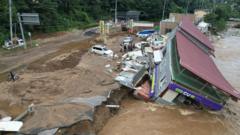In response to the calamity, President Lee Jae-myung has ordered special disaster designations for affected areas, mobilizing a full-scale recovery operation amid forecasts of further severe weather conditions.
At least 17 people have died in floods and landslides caused by days of torrential rain in South Korea, according to the country's disaster management office. Fears are mounting that the death toll could rise as emergency rescue efforts continue, with 11 individuals reported missing. Disturbing footage has emerged, showing residents wading through thick mud in the landslide-stricken resort town of Gapyeong as they attempt to reach evacuation shelters.
In the central Chungcheong region, a landslide engulfed an entire village, burying it in earth and debris, while another landslide in northern Gapyeong County claimed two lives when several properties were overtaken by mud, as reported by AFP. The majority of the destruction has been localized to the south, where six fatalities have been reported in Sancheong alone.
The torrential rain, which began on Wednesday, has led to significant infrastructural damage, with thousands of roads and buildings submerged. Nearly 10,000 South Koreans have been forced to evacuate their homes during this crisis, and over 41,000 households are reportedly without power. Despite the rain gradually subsiding in the worst-hit regions, the downpours have shifted north, and further heavy rain is anticipated in capital city Seoul and surrounding areas.
In light of the disaster, President Lee has declared certain regions as special disaster zones and initiated a multi-agency recovery effort, with Interior Minister Yun Ho-jung urging local authorities to deploy "all available resources" to aid those affected. As cleanup efforts commence in Gwangju, authorities remain cautious, with predictions of an impending heatwave once the rains conclude.
At least 17 people have died in floods and landslides caused by days of torrential rain in South Korea, according to the country's disaster management office. Fears are mounting that the death toll could rise as emergency rescue efforts continue, with 11 individuals reported missing. Disturbing footage has emerged, showing residents wading through thick mud in the landslide-stricken resort town of Gapyeong as they attempt to reach evacuation shelters.
In the central Chungcheong region, a landslide engulfed an entire village, burying it in earth and debris, while another landslide in northern Gapyeong County claimed two lives when several properties were overtaken by mud, as reported by AFP. The majority of the destruction has been localized to the south, where six fatalities have been reported in Sancheong alone.
The torrential rain, which began on Wednesday, has led to significant infrastructural damage, with thousands of roads and buildings submerged. Nearly 10,000 South Koreans have been forced to evacuate their homes during this crisis, and over 41,000 households are reportedly without power. Despite the rain gradually subsiding in the worst-hit regions, the downpours have shifted north, and further heavy rain is anticipated in capital city Seoul and surrounding areas.
In light of the disaster, President Lee has declared certain regions as special disaster zones and initiated a multi-agency recovery effort, with Interior Minister Yun Ho-jung urging local authorities to deploy "all available resources" to aid those affected. As cleanup efforts commence in Gwangju, authorities remain cautious, with predictions of an impending heatwave once the rains conclude.



















